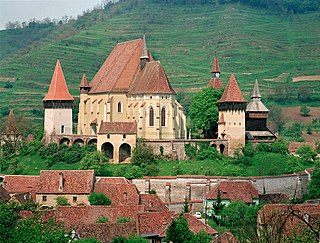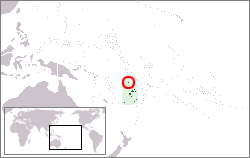
Fiji, officially the Republic of Fiji is an island country in Melanesia, part of Oceania in the South Pacific Ocean about 1,100 nautical miles northeast of New Zealand's North Island. Its closest neighbours are Vanuatu to the west, New Caledonia to the southwest, New Zealand's Kermadec Islands to the southeast, Tonga to the east, the Samoas and France's Wallis and Futuna to the northeast, and Tuvalu to the north. Fiji consists of an archipelago of more than 330 islands—of which 110 are permanently inhabited—and more than 500 islets, amounting to a total land area of about 18,300 square kilometres (7,100 sq mi). The most outlying island is Ono-i-Lau. The two major islands, Viti Levu and Vanua Levu, account for 87% of the total population of 883,483. The capital, Suva, on Viti Levu, serves as the country's principal cruise-ship port. About three-quarters of Fijians live on Viti Levu's coasts, either in Suva or in smaller urban centres such as Nadi—where tourism is the major local industry—or Lautoka, where the sugar-cane industry is paramount. Due to its terrain, the interior of Viti Levu is sparsely inhabited.

Suva is the capital and largest metropolitan city in Fiji. It is located on the southeast coast of the island of Viti Levu, in the Rewa Province, Central Division.

The south-eastern Transylvania region in Romania currently has one of the highest numbers of existing fortified churches from the 13th to 16th centuries. It has more than 150 well preserved fortified churches of a great variety of architectural styles.

Rotuma is a Fijian dependency, consisting of Rotuma Island and nearby islets. The island group is home to a large and unique indigenous ethnic group which constitutes a recognisable minority within the population of Fiji, known as "Rotumans". Its population at the 2017 census was 1,594, although many more Rotumans live on mainland Fijian islands, totaling 10,000.
Fijian is an Austronesian language of the Malayo-Polynesian family spoken by some 350,000–450,000 ethnic Fijians as a native language. The 2013 Constitution established Fijian as an official language of Fiji, along with English and Fiji Hindi, and there is discussion about establishing it as the "national language". Fijian is a VOS language.
Fijians are a nation and ethnic group native to Fiji, who speak Fijian and share a common history and culture.

Vanua Levu, formerly known as Sandalwood Island, is the second largest island of Fiji. Located 64 kilometres to the north of the larger Viti Levu, the island has an area of 5,587.1 square kilometres (2,157.2 sq mi) and a population of 135,961 as of 2007.

Viti Levu is the largest island in the Republic of Fiji, the site of the nation's capital, Suva, and home to a large majority of Fiji's population.

The White Towns of Andalusia, or Pueblos Blancos, are a series of whitewashed towns and large villages in the northern part of the provinces of Cádiz and Málaga in southern Spain, mostly within the Sierra de Grazalema Natural Park.
The House of Chiefs in Fiji consists of the Fijian nobility, composed of about seventy chiefs of various ranks. It is not a formal political body and is not the same as the former Great Council of Chiefs, which was a political body with a prescribed constitutional role, although the membership of the two bodies did overlap to a great extent.

Sørvágur is a village on the island of Vágar in the Faroe Islands.
The culture of Fiji is a tapestry of native Fijian, Indian, European, Chinese, and other nationalities. Culture polity traditions, language, food costume, belief system, architecture, arts, craft, music, dance, and sports which will be discussed in this article to give you an indication of Fiji's indigenous community but also the various communities which make up Fiji as a modern culture and living. The indigenous culture is an active and living part of everyday life for the majority of the population.

Sigatoka is a town in Fiji. It is found on the island of Viti Levu and is situated at the mouth of the Sigatoka River, after which it is named, some 61 kilometres from Nadi. In Fiji's last census (2007) the population of Sigatoka was at 9,622. Sigatoka is the principal urban centre for the province of Nadroga-Navosa.

Armoy is a village and civil parish in County Antrim, Northern Ireland. It is 5.5 miles (9 km) southwest of Ballycastle and 8 miles (13 km) northeast of Ballymoney. According to an estimate in 2013 by the Northern Ireland Statistics and Research Agency it had a population of 1,122.
The Nausori Highlands are located in the interior of Fiji's main island Viti Levu. One of the most picturesque villages is Navala. The Nausori Highlands are a great place to learn about Fijian culture.
Fijian tradition and ceremony is a living way of life that has remained intact for millennia, evolving as the Fijian nation has modernised over time, with various external influences from Pacific neighbours, and European and Asian society. The term Fijian in this article refers to "indigenous Fijians" or "I Taukei" as the term Fijian generally includes all citizens of Fiji. This article is a general overview of various aspects of Fijian tradition, social structure and ceremony, much of it from the Bauan Fijian tradition. There are variations from province to province. Many social intricacies depend on one's inherited social position and the occasion one is confronted with: each will have a particular social etiquette. The Fijian terms in this article are most often of the Bauan dialect.

Icklingham is a village in the West Suffolk district of the English county of Suffolk. It is about 7 miles (11 km) north-west of Bury St Edmunds, 4 miles (6.4 km) south-east of Mildenhall and 9 miles (14 km) south-west of Thetford in Norfolk. The village is on the A1101 road between Bury St Edmunds and Mildenhall in the north-west of the county. The area around the village, characterised by a sandy gravel-laden soil, is known as Breckland, though an arm of the fen-like peat follows the River Lark past the village.
Fijian cuisine has traditionally been very healthy. Fijians prefer a more tuber and coconut based diet. High caloric foods are good for hard-working villagers who need extra calories while working on their farms but this causes a range of chronic illness such as obesity. Fiji is a multicultural country and is home to people of various races. In most Fijians' homes, food of other cultures is prepared on a regular basis such as Indian curries and Chinese dishes. Fiji is also famous for its seafood.
Indo-Fijians or Indian-Fijians, are Fiji citizens who are fully or partially of Indian descent, which includes descendants who trace their heritage from various regions of the Indian subcontinent. Although Indo-Fijians constituted a majority of the Fijian population from 1956 through the late 1980s, discrimination and the resulting brain drain has resulted in them numbering 313,798 (37.6%) out of a total of 827,900 people living in Fiji today.

The majority of Fiji's islands were formed through volcanic activity starting around 150 million years ago. Today, some geothermic activity still occurs on the islands of Vanua Levu and Taveuni. Fiji has been inhabited since the second millennium BC and was settled first by Austronesians and later by Melanesians, with some Polynesian influences. Europeans visited Fiji from the 17th century, and, after a brief period as an independent kingdom, the British established the Colony of Fiji in 1874. Fiji was a Crown colony until 1970, when it gained independence as the Dominion of Fiji. A republic was declared in 1987, following a series of coups d'état.












